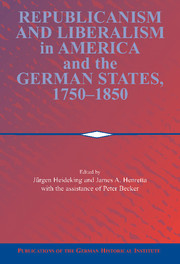Book contents
- Frontmatter
- Introduction
- PART I OVERVIEW
- PART II THE REPUBLICAN WORLD
- PART III THE TRANSITION FROM REPUBLICANISM TO LIBERALISM
- 7 The Liberal and Democratic Republicanism of the First American State Constitutions, 1776-1780
- 8 Bennington and the Green Mountain Boys: The Emergence of Liberal Democracy in Vermont, 1760-1850
- 9 The Birth of American Liberalism: New York, 1820-1860
- 10 Republicanism, Liberalism, and Market Society: Party Formation and Party Ideology in Germany and the United States, c. 1825-1850
- 11 Festive Culture and National Identity in America and Germany, 1760-1860
- 12 Charles Follen’s View of Republicanism in Germany and the United States, 1815-1840
- PART IV THE LOGIC OF LIBERALISM
- Index
9 - The Birth of American Liberalism: New York, 1820-1860
Published online by Cambridge University Press: 05 January 2013
- Frontmatter
- Introduction
- PART I OVERVIEW
- PART II THE REPUBLICAN WORLD
- PART III THE TRANSITION FROM REPUBLICANISM TO LIBERALISM
- 7 The Liberal and Democratic Republicanism of the First American State Constitutions, 1776-1780
- 8 Bennington and the Green Mountain Boys: The Emergence of Liberal Democracy in Vermont, 1760-1850
- 9 The Birth of American Liberalism: New York, 1820-1860
- 10 Republicanism, Liberalism, and Market Society: Party Formation and Party Ideology in Germany and the United States, c. 1825-1850
- 11 Festive Culture and National Identity in America and Germany, 1760-1860
- 12 Charles Follen’s View of Republicanism in Germany and the United States, 1815-1840
- PART IV THE LOGIC OF LIBERALISM
- Index
Summary
Ideology is not self-implementing. Although Lockean liberal ideas of natural rights and representative government filtered into Britain's North American colonies, they did not significantly affect the existing system of politics. Nor, in New York, did the libertarian and egalitarian principles of the American Revolution overthrow the traditional ruling elite of merchants and landlords. The New York Constitution of 1777 was a conservative republican document that preserved traditional property qualifications for voting and legally protected the huge estates of the Hudson River gentry. Moreover, after 1790 New York, along with other American state governments, adopted neomercantilist policies designed to enhance the republican “common-wealth,” largely ignoring the liberal principles of political economy advanced by Adam Smith. Liberalism - as a functioning system of government, economic policy, and cultural ideals - emerged in New York State only in the mid-nineteenth century as newly emergent social groups - professional party politicians, rural smallholders, and an entrepreneurial urban bourgeoisie - seized control of the political system.
MARTIN VAN BUREN AND THE POLITICAL REVOLUTION OF 1821
The architect of liberalism in New York State was Martin Van Buren (1782–1862).To his admirers Van Buren was “Little Van” a “Little Magician” with great personal charm and political skills; to his enemies he was “an artful, cunning, intriguing, selfish lawyer” concerned only with “office and money.” In truth,Van Buren was a complex man whose bourgeois skills and ambition – hard work, rational calculation, and disciplined selfcontrol – propelled him into the first ranks of American public life. Beginning as a state senator (1812–20) and the state’s attorney general (1815–19), Van Buren turned the “Bucktail” Republicans into a disciplined political party that secured his election as United States senator (1821–8) and governor of New York (1829).Then, as the prime strategist of the coalition of the “plain republicans”of the North and the planters of the South that swept Andrew Jackson into the presidency, the New Yorker assumed high national positions, serving as secretary of state (1829–31), vice president (1833–7), and the eighth president of the United States (1837–41).
- Type
- Chapter
- Information
- Publisher: Cambridge University PressPrint publication year: 2002

